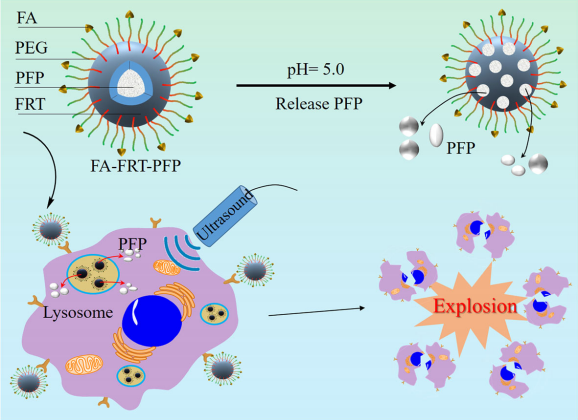文献:pH- and acoustic-responsive platforms based on perfluoropentane-loaded protein nanoparticles for ovarian tumor-targeted ultrasound imaging and therapy
文献链接:https://xueshu.baidu.com/usercenter/paper/show?paperid=1s5v0680uc5n06k0tv3v06y0g5691474&site=xueshu_se
作者:Jianping Li, Hong Ji, Yong Jing and Shiguang Wang
相关产品:
NH2-PEG2000-COOH 氨基-聚乙二醇2000-羧基
原文摘要:In this study, we developed a multifunctional ultrasound (US) therapeutic agent that encapsulates perfluoropentane (PFP) into ferritin (FRT) and conjugates the tumor-targeting molecule folic acid (FA) (FA-FRT-PFP). The prepared FAFRT-PFP had an average particle diameter of 42.8 ± 2.5 nm, a zeta potential of − 41.1 ± 1.7 mV and shows good stability in physiological solution and temperatures. FRT is a pH-sensitive cage protein that, at pH 5.0, disassembles to form pores that can load PFP. The adjustment to neutral pH closes the pores and encapsulates the PFP inside the FRT to form nanoparticles. At pH 5.0, 3 min of low-intensity focused ultrasound (LIFU, 2 W/cm2 ) significantly enhanced the US signal of FA-FRT-PFP through the acoustic droplet vaporization (ADV) effect. Under identical conditions, 4 min of LIFU
irradiation caused the bubbles generated by FA-FRT-PFP to break. FA-FRT-PFP could be efficiently targeted into ovarian cancer cells and significantly enhanced the US contrast of FA-FRT-PFP after 3 min of LIFU irradiation. After 4 min of LIFU irradiation, cell viability significantly decreased due to necrosis, likely due to the FA-FRT-PFP mediated release of PFP in the acidic environment of lysosomes after entering the tumor cells. PFP is then transformed into bubbles that burst under LIFU irradiation, forming physical shock waves that lead to the destruction of the cell structure and necrosis, achieving tumor treatment. Taken together, this demonstrates that FA-FRT-PFP is both a novel and promising US theranostics agent for future clinic application.
NH2-PEG2000-FA是一种功能化的聚乙二醇衍生物。它包含了氨基(NH2)、聚乙二醇(PEG2000)链段和叶酸(FA)基团。氨基可用于进一步的化学反应,例如与含有羧基、活性酯等官能团的分子进行偶联,为材料的改性和生物分子的固定提供活性位点。PEG2000链段具有良好的水溶性、生物相容性和柔性。其亲水性使得该化合物在水性环境中表现出良好的溶解性,能减少与周围生物环境的非特异性相互作用。叶酸基团则赋予了该化合物对叶酸受体的特异性识别能力。NH2-PEG2000-COOH 是一种线性杂双功能聚乙二醇衍生物。羧基能与羟基等发生酯化反应等。这种功能性使其成为一种非常有用的交联剂,可用于将功能性 PEG 附着到生物分子、颗粒和其他材料表面。可用于纳米颗粒、纳米胶束等材料的表面修饰,改变其表面性质、溶解度和稳定性。引用的这篇文献就基于以上两种产品的性质制备FA-FRT-PFP纳米颗粒,制备过程如下:

图:FA-FRT-PFP的合成及应用示意图
FA-FRT-PFP的制备
首先,通过酯化反应将目标分子FA与FRT结合。将NH2-PEG2000-FA和FRT溶液与EDC和NHS的存在混合。在室温下轻微搅拌反应后,用蒸馏水透析纯化混合物。所得到的溶液为FA-FRT纳米颗粒。其次,采用蛋白变性和复性的过程制备了将PFP装入FRT腔内。简单地说,将FA-FRT稀释到PBS中,并在室温下轻微搅拌,调整至pH,以确保FRT完全解离。然后,在冰浴中加入PFP溶液,在冰浴中脉冲超声,将混合物的pH值调整到中性。由于PFP为油态,在水中不能溶解,过量的PFP很容易被液体分离去除为FAFRT-PFP。FRT-PFP除将NH2-PEG2000-FA转化为氨基-PEG2000-COOH外,采用类似的方法制备。

图:FRT、FRT-PFP和FA-FRT-PFP的透射电镜图像。
结论:基于frt和PFP负载的相变纳米颗粒,其修饰为FA靶分子(FA-FRT-PFP)。NH2-PEG2000-FA参与制备的FA-FRT-PFP具有多种优势: (1) FA-FRT-PFP具有纳米级粒径;(2)以FRT作为载体,分别在酸性和中性条件下上传和释放PFP液滴;(3)在3 min LIFU辅助和酸性条件下,FA-FRT-PFP释放PFP并通过ADV产生相变,可提高对比度。

 2025-02-13 作者:ZJ 来源:
2025-02-13 作者:ZJ 来源:

